by Heather Kent | Sep 28, 2017
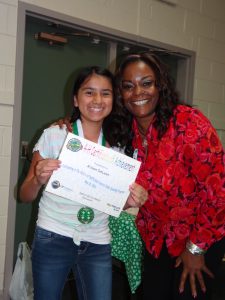 4-H Standards of Excellence are tools to help individual members and clubs set and achieve goals and are part of our recognition model. Recognition is an important part of the 4-H experience; it helps master skills and knowledge by providing feedback on progress towards goals. Standards of Excellence is one of my favorite ways to recognize youth and clubs. Here’s how it works:
4-H Standards of Excellence are tools to help individual members and clubs set and achieve goals and are part of our recognition model. Recognition is an important part of the 4-H experience; it helps master skills and knowledge by providing feedback on progress towards goals. Standards of Excellence is one of my favorite ways to recognize youth and clubs. Here’s how it works:
At the beginning of the 4-H year, youth decide which level of recognition they would like to receive. The levels are bronze, silver, gold and emerald. To help youth decide, they should review the Standard of Excellence matrix with their parent or club leader. The matrix outlines what a member needs to do in order to achieve each level of recognition. For example, if a junior member (ages 8-10) wants to achieve the gold standard, he/she would need to plan to do the following throughout the course of the 4-H year:
- Attend at least 2/3 of club meetings (or number established by club).
- Share project experiences by giving a presentation.
- Attend three different activities
- Participate in three different activities
- Participate in three community service activities
- Participate in four different competitions / exhibitions
- Complete two project record reports
- Teach one club level activity
- Make a poster on “My 4-H Experience” or submit Building My 4-H Portfolio
 But wait, that’s not all! 4-H Clubs can also achieve Standards of Excellence. During the club organizational meeting, members can choose which type of club they want to be (bronze, silver, gold or emerald), and build those requirements into their club plan (most of the items are things that clubs would want to do anyway, so why not be recognized for it?):
But wait, that’s not all! 4-H Clubs can also achieve Standards of Excellence. During the club organizational meeting, members can choose which type of club they want to be (bronze, silver, gold or emerald), and build those requirements into their club plan (most of the items are things that clubs would want to do anyway, so why not be recognized for it?):
- Bronze club- 12/20 items on the list
- Silver club- 14/20 items on the list
- Gold club-16/20 items on the list
- Emerald club- 18/20 items on the list
Once a member or club establishes their goal, they can submit their plan to their club leader. Towards the end of the 4-H Year, the member submits their application to their leader, who signs off on it and submits it to their 4-H agent. Youth are recognized during their County Achievement Night, or Awards Banquet.
Interested in helping? We need volunteers to serve as project mentors, review/judge awards applications or help plan annual recognition programs. Contact your local UF IFAS County Extension Office if you would like to get involved.
by Heather Kent | Sep 21, 2017

This article will help you know what to expect at your first club meeting.
Is your family new to 4-H? Welcome! We are glad you chose us to help your child reach his/her fullest potential. Here are a few basics to help you become familiar with 4-H as you begin your journey with us:
- The 4-H year starts September 1st through August 31st. Whatever your child’s age is on September 1st is his/her “4-H Age” and determines his/her eligibility for certain programs.
- There are four age divisions in 4-H (you can find policies for participation based on age here):
- Cloverbuds (ages 5-7)
- Juniors (ages 8-10)
- Intermediates (ages 11-13)
- Seniors (ages 14-18)
- Youth can participate in 4-H through a variety of methods (camps, school programs, after school programs, and clubs). Youth can participate in all or just one of these delivery modes, or types of 4-H memberships.
- To join a club, you will want to enroll through 4HOnline. Many counties offer an Open House, or Kickoff night where families can preview the different types of clubs available in their community. Some clubs offer a variety of projects, while other clubs focus on a particular project (like archery or sewing) or a project area (like animal science or leadership). Some clubs meet all year and others may only meet for six consecutive weeks (SPIN clubs- special interest clubs). If you are not sure which club is the best fit for your family, schedule an appointment with your local UF IFAS 4-H Extension Agent.

Talk to your local 4-H Agent to decide which club best suits your family.
Preparing for your first club meeting:
- There is no uniform for 4-H, but some clubs will order shirts for youth to wear when they go on field trips or compete in contests.
- Clubs typically open with icebreakers, or get to know you games (especially at the beginning of the 4-H year).
- The club business meeting lasts about 1/4 of the total club meeting and is always opened with the American Pledge and the 4-H Pledge. Check out this video to learn the 4-H Pledge. During the business meeting, youth will give committee reports, discuss and vote on club business, and announce other 4-H opportunities. Clubs made up of primarily Cloverbud members do not have elected officers, but encourage members to take turn leading the pledges and helping with the business meetings.
- The first club meeting is the organizational meeting. During this meeting, youth will plan the club calendar and elect officers. If it is a new club, they will also select a name for the club.
- Once the club calendar is set, about half of the club meeting time will be spent on educational activities. This may include a guest speaker, field trip, or a hands-on activity to learn about a subject or project area.
- Every club participates in at least one service project each year, decided on by the club members.
- The last 1/4 of the meeting is usually spent on recreation- this can be icebreakers or team building activities. Sometimes, it is just a time to socialize while enjoying light refreshments.
What is the role of the parent? 4-H is a family affair, offering many opportunities where both child and parent participate in common interests. This not only strengthens the club, but strengthens family ties. When parental support is positive, the club is likely to become stronger, larger, and more active because parent volunteers help broaden the scope and reach of the club. A few ways parents can support and strengthen the club include:
- Arriving on time and being prepared (if working project books, make sure your child has theirs)
- Offering to help with a club meeting or activity
- Sign up to help with refreshments
- Offer to share a skill or knowledge that you have by becoming a 4-H project leader
We are glad to have you as a part of our 4-H Family and look forward to getting to know yours!
by bestevez | Sep 14, 2017
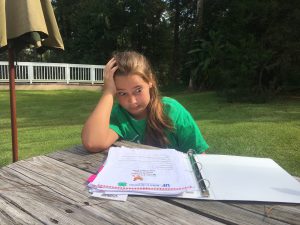
No need to dread the record book! This article breaks it down into simple steps.
In 4-H, young people have tracked their activities, events, profits and losses, skill development and learning experiences, and much more using the iconic 4-H Record Book. In addition to record keeping, the 4-H Record Book gives members an opportunity to reflect on their year, measure their achievements and growth, set goals, and develop plans to meet those goals. Once you understand the purpose and value of record books, you are probably wondering where to start. Here are the most frequently asked questions about record books to simplify the process:
What’s the difference between a project book and a record book? A project book guides youth through the project and includes background information and activities to help them master the subject matter. A record book is the record of what youth did and learned in the project and documents goals, knowledge and skills gained, leadership experiences, awards earned, and service to the community. Record books are typically bound in a cover, scrapbook or three-ring binder and turned in for evaluation at the end of the project or 4-H year.
Some project books include a records section, but many do not. If your project does not have a section for records, then you will want to insert a Florida 4-H Project Report Form (based on your age level).
What types of information should I keep track of for my record book?
|
Cloverbuds |
Juniors |
Intermediates |
Seniors |
| Personal information |
Name, 4-H age, club, # of years in 4-H, member, parent/club leader signatures |
| Project Plans and Goals |
NA |
What are your goals (run for office, attend a workshop, earn a blue ribbon in showmanship) |
| Project Highlights |
A list of activities you did this year (demonstrations, field trips, leadership activities, workshops, exhibits) |
| Project Attachments |
Photos of you doing project activities; newspaper clippings, club or workshop programs, exhibitor tags, cage cards, feed tags |
| Project Story, or Reflection |
NA |
What you learned, who helped you, what you liked (or disliked) about the project, what you would do differently next time, whether or not you encountered any problems and what you did to overcome them |
| Financial Records |
Financial records are usually only associated with animal science, gardening and entrepreneurship projects. Not all record books will have a financial record section. |
How do I keep up with all that information?
| Calendar |
Have a calendar dedicated to your 4-H work and record your activities- club meetings, workshops, how often you feed or water your project, shows or exhibits, etc. |
| Index box |
Keep a recipe box full of index cards with dividers for each section of the record book. Each time you do something related to one of the sections, write it on the card. |
| Notebook |
Keep a journal of your project, recording activities. You can even divide the notebook into sections that correspond with each section of your record book |
| Electronic Device |
Yes! There is an app for that. Sponsored by Tractor Supply and National 4-H Council, there is a market animal record book app you can download from iTunes. |
To inspire you, here are some quotes that Florida 4-H youth wrote in their record books:
- “As the VP (vice president) of my club, I had many opportunities to speak in front of a crowd. This has helped me in other aspects of my life such as school. I have become a better public speaker.”
- “I have taken bigger and better responsibilities. I learned to be responsible and to challenge myself to bigger expectations and to be kind, nice, and pleasant to others.”
- “4-H has given me the opportunity to do things that I normally would not get to do.”
- “4-H has meant a lot to me because it teaches me so much about my project and our world. (I learned) to follow safety practices, treating animals with respect, being careful when leading an animal and watching out for others and their animals.”
As we start the 2017-2018 4-H year, think about your 4-H project area and how you will document it this year. If you have a skill to share and would like to inspire the next generation, consider becoming a 4-H volunteer. We offer a wide variety of roles to fit your interests and schedule. For more information about 4-H, visit our website or contact your local UF IFAS County Extension Office.
by Heather Kent | Aug 28, 2017

Photo credit: National 4-H Council
September 1st marks the new 4-H year in Florida, and many families are enrolling their kids this week. There are several different ways that youth can participate in 4-H. The most traditional delivery mode is community clubs, but youth can also participate through their school or afterschool program, military youth center, camp, or even as a short-term special interest member.
Last year, Florida 4-H introduced a membership fee for community club members ages 8-18 of $20.00. Many parents have asked me, “Why is Florida 4-H charging community clubs? Many club kids are enrolled in projects where parents have already invested money into animals or equipment (shooting sports, robotics, sewing machines).” I am one of those parents- my own children are enrolled in the poultry project and would like to advance to a rabbit, pig or steer. As a parent who has paid the fee, I see it as an investment, and here’s why:
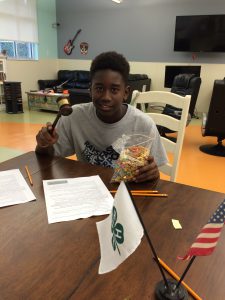
Photo credit: Paula Davis, UF IFAS Bay County
Although every 4-H delivery mode incorporates positive youth development strategies, research shows that the club delivery mode has the greatest benefit to youth. A few years ago, Tufts University did a groundbreaking study on Positive Youth Development. They studied youth engaged in a variety of youth programs (including 4-H) and they tracked the youth from 5th grade until graduation. Florida participated in this study and the results were exciting for 4-H! You can read the full report here. Based on this research, compared to youth in other youth programs, youth engaged in 4-H clubs are:
- Four times more likely to contribute to their communities
- Two times more likely to be civically active
- Two times more likely to participate in STEM (science, technology, engineering and math) activities during out-of-school time
- Two times more likely to make healthier choices
- 4-H girls are two times more likely to take part in science programs compare to girls in other youth program
So as a parent, I see the club membership fee as an investment. Twenty dollars is way less than what I pay so that my kids can play soccer for a couple of months each year (and depending on the coach- my kids may or may not learn sportsmanship and teambuilding). There isn’t anything on the list above that I don’t want for my children. But these outcomes are all tied to long term involvement with a 4-H club. Clubs are the most effective delivery mode for positive youth development because they focus on three very important areas:
- Positive and sustained relationships between youth and adults
- Activities that build important life skills
- Opportunities for youth to use these skills as participants and leaders in valued community activities
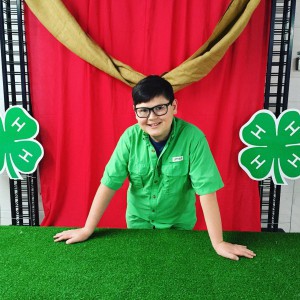
Photo credit: Julie Dillard, UF IFAS Washington County
So if 4-H sounds like a good investment to you, here’s how to enroll (if you are a member of more than one club, you pay the membership only one time per year):
NEW 4-H Members:
- Log onto https://florida.4honline.com
- Create a family profile.
- Enroll individual youth.
- Each youth must have a club and project (select from the drop-down menu).
- You will receive an email with a link to pay the Florida 4-H Membership Fee after enrolling.
- Pay the Florida 4-H Membership Fee. If you don’t want to pay online, you can drop off cash, check or money order at your local UF IFAS County Extension Office using this form.
- Membership will be set to active after fee is paid. Until
membership fee is paid, youth cannot attend 4-H club meetings, events or activities.
RETURNING 4-H Members:
- Log onto https://florida.4honline.com
- Enter your email address and password.
- Update contact, medical, club and project information for each member.
- Each youth must have a club and project (select from the drop down menu).
- You will receive an email with a link to pay the Florida 4-H Membership Fee after enrolling.
- Pay the Florida 4-H Membership Fee. If you don’t want to pay online, you can drop off cash, check or money order at your local UF IFAS County Extension Office using this form.
- Membership will be set to active after fee is paid. Until membership fee is paid, youth cannot attend 4-H club meetings, events or activities.
Many counties are planning 4-H kickoffs this time of year, and those events are a great way to learn about the different clubs available in your community. If the fee is a hardship for your family, contact the 4-H agent for possible scholarships. For more information about 4-H, contact your local UF IFAS County Extension Office or visit http://florida4h.org.
by amgranger | Apr 27, 2017
“This group is inclusive, which gives both children with and without disabilities an opportunity to learn from each other. Our hope is that our group will continue to grow and that through participating in our ASK group, individuals and families might gain the desire and/or confidence, to explore other 4-H groups that are geared toward specific interests.”
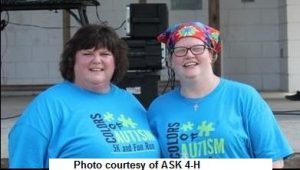
Ann Marie Shelton and Syntha Alvarez
On day four of National Volunteer Week, Jackson County 4-H Agent Angel Granger shares the story of Ann Marie Shelton, a volunteer who leads the Jackson County 4-H ASK Club – Always Support Kids. In her own words, Ann Marie shares what inspired her to start this club and the impact it has had:
“The volunteer part is deep rooted, goes back to me as a very small child. I enjoyed helping others, it made me feel good! That stuck with me through the years. There is so much going on in the world that is tough to hear. I firmly believe that we have the power to change much of this. Volunteering time, expertise, and a dash of passion will do much to make this world a better place. When volunteering, you are given the opportunity to lead by example, by not waiting around for good or needed things to happen you are showing that everyone has the capacity within themselves to be a part of the change. This may require you to step out of your comfort zone and start something new or join a group of volunteers already working on a cause of interest to you. One benefit of volunteering is you get to choose areas to volunteer that are of interest to you, whether it be something you are passionate about or something you want to learn about.
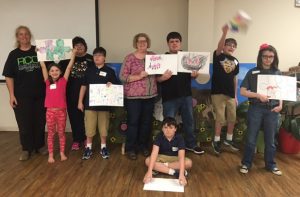
ASK Volunteer Anne Marie Shelton (pictured 3rd L-R) with her club members.
After having my four children, two of which are diagnosed on the autism spectrum and reconnecting with a friend from High School with two children on the autism spectrum, volunteering became even more important to me. What we have found, living in our rural part of the state of Florida, is that there are few formal services or programs offered for children with exceptional needs. I like to refer to these as diffabilities (I did not come up with this word, but it is perfect). When our son was diagnosed with an Autism Spectrum Disorder (ASD) and was having such difficulties in certain settings outside the home, our instinct was to withdraw to the safety of our home, not pursuing social opportunities outside the home, that were new or unfamiliar.
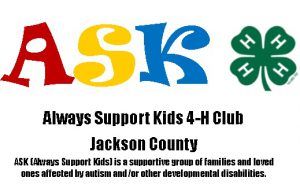 Eventually we realized that was not in anyone’s best interest. After diagnosis, we began connecting with families and organizations all over the panhandle of Florida that were on similar missions. We also came to realize that we needed to expand on special interests and explore potential new interests, leisure opportunities, future job skills and the like. We had been following the ASK-Madison 4-H Group on Facebook and had made connections with Leslie McLeod. When the opportunity arose last year at Family Café, an annual disabilities related conference in Florida, to hear about their 4-H program, we jumped at the chance to find out more. After getting to hear them talk about their program and finding out about the number of diverse opportunities 4-H offers, we decided to give it a go, in our community so we contacted our 4-H agent Angel Granger to find out how to get started. We wanted to provide a group that families could feel comfortable in participating in. We wanted those families to know, that we understand the best way for our kids to learn about participating in group activities and activities within our community, was to experience it. They often need a safe place to start, to let down their guards, to learn new skills and more importantly be given a multitude of opportunities to practice those new skills, in different situations, with different people, in different environments.”
Eventually we realized that was not in anyone’s best interest. After diagnosis, we began connecting with families and organizations all over the panhandle of Florida that were on similar missions. We also came to realize that we needed to expand on special interests and explore potential new interests, leisure opportunities, future job skills and the like. We had been following the ASK-Madison 4-H Group on Facebook and had made connections with Leslie McLeod. When the opportunity arose last year at Family Café, an annual disabilities related conference in Florida, to hear about their 4-H program, we jumped at the chance to find out more. After getting to hear them talk about their program and finding out about the number of diverse opportunities 4-H offers, we decided to give it a go, in our community so we contacted our 4-H agent Angel Granger to find out how to get started. We wanted to provide a group that families could feel comfortable in participating in. We wanted those families to know, that we understand the best way for our kids to learn about participating in group activities and activities within our community, was to experience it. They often need a safe place to start, to let down their guards, to learn new skills and more importantly be given a multitude of opportunities to practice those new skills, in different situations, with different people, in different environments.”
The group is inclusive, which gives both children with and without disabilities an opportunity to learn from each other. Our hope is that our group will continue to grow and that through participating in our ASK group, individuals and families might gain the desire and/or confidence, to explore other 4-H groups that are geared toward specific interests.”
If you are interested in starting a similar club in your county (or helping other volunteers support exceptional youth), contact your local UF IFAS County Extension Office or visit http://florida4h.org.
ASK Jackson County 4-H Facebook
Chipola Area Autism Resource Center, Inc. Facebook
by Melanie Taylor | Mar 23, 2017
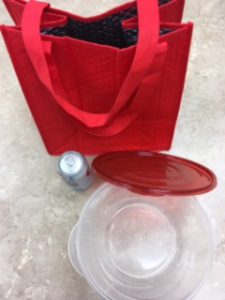
Do you remember the 3 R’s? If you are over the age of forty you are probably thinking of a classroom, a teacher, and learning about Reading, wRiting, and aRithmetic. These are the basic standards for learning, of course. However, it is now 2017and the 3 R’s have a new meaning to a new generation of young people: Reduce, Reuse, Recycle!
In today’s society, we constantly hear concerns about the environment and how we need to implement changes to make a positive impact upon its future. It is nearly impossible to pay attention to any media without feeling bombarded by messages of conservationism. “Go Green!” “Green… it’s the new black.” “Reduce, Reuse, Recycle.” However, are these sentiments new? Think about it. “Give a Hoot… Don’t Pollute.” “Keep America Beautiful.” “Keep Our Forests Green.” The use, or abuse, of our natural resources has long been an issue debated by our nation. It has more or less been the price we have had to pay for progress; but regardless of one’s political views and beliefs, the fact that Earth is the only planet that will sustain human lives is a hard fact to deny. It is therefore critical that all of promote principles of conservationism for our future generations.
The practice of reducing, reusing, and recycling may be easily incorporated into many aspects of your everyday lives. As YOU reduce, reuse, and recycle in your daily lives, you will be teaching by example your own children at home. Knowing that youth learn by seeing and doing, they will be much more likely to implement the practices of reducing, reusing and recycling into their own daily lives if they see you practicing the 3 R’s in yours.
How does the Environmental Protection Agency describe each of the 3 R’s? Reduce the amount and toxicity of trash you throw away. One way is to turn off or unplug lights during the day. Doing so will save energy and help your lights last longer. Use food scraps, yard trimmings, and other organic wastes to create a compost pile. Adding the compost you make to soil increases water retention, decreases erosion, and keeps organic materials out of landfills. Reuse containers and products. There are many creative ways to reuse items, which might normally find their way into the waste stream: old shoeboxes may be used for storage, plastic containers for planters, etc. You can also donate or give away items rather than throwing these items away. For a large number of unwanted items, you can hold a garage sale. It is also encouraged to shop at garage sales before buying new!
Recycle as much as possible and buy products with recycled content. Recycling includes collecting, sorting and processing certain solid waste into raw materials for re-manufacture into new items. These all help to cut down on the amount of waste we throw away. They conserve natural resources, landfill space and energy.
In addition, the three R’s save land and money communities must use to dispose of waste in landfills.These are all things we can do daily with just a little thought and effort. In fact, businesses are making it easier for us every day. We can reduce our trash in many ways, but an easy way is to reuse water bottles instead of throwing them away after each use. We can use the reusable bags that many stores now offer for our purchases; this is a great alternative to using plastic shopping bags. Of course, we can all make more of an effort to recycle by collecting our newspapers, aluminum cans, plastic bottles and glass jars for local recycling centers. If there are not recycling centers in your area maybe you should start one or pursue your community leaders about the importance of having one.
A few points to consider…
- The average American produces about 4.5 lbs. of garbage per person per day. This equal 235 million tons a year.
- Recycling 1 ton of paper saves 17 mature trees.
- Recycling 1 aluminum beverage can saves enough energy to run a 100 watt light bulb for 20 hours, a computer 3 hours, or a TV for 2 hours. (Currently, 45% of aluminum cans are recycled.)
- Reduce and reuse by donating old clothes and items to charities.
By instilling the importance of the 3 R’s into today’s society we will be helping clean the planet for the future. After all, “A true conservationist is a man who knows that the world is not given by his fathers but borrowed from his children.” As quoted by John James Audubon. Our state 4-H service project theme for next year is the environment. Why not consider planning a club, county or district service learning project in honor of Earth Day?
Source:
United States Environmental Protection Agency , https://www.epa.gov
 4-H Standards of Excellence are tools to help individual members and clubs set and achieve goals and are part of our recognition model. Recognition is an important part of the 4-H experience; it helps master skills and knowledge by providing feedback on progress towards goals. Standards of Excellence is one of my favorite ways to recognize youth and clubs. Here’s how it works:
4-H Standards of Excellence are tools to help individual members and clubs set and achieve goals and are part of our recognition model. Recognition is an important part of the 4-H experience; it helps master skills and knowledge by providing feedback on progress towards goals. Standards of Excellence is one of my favorite ways to recognize youth and clubs. Here’s how it works: But wait, that’s not all! 4-H Clubs can also achieve Standards of Excellence. During the club organizational meeting, members can choose which type of club they want to be (bronze, silver, gold or emerald), and build those requirements into their club plan (most of the items are things that clubs would want to do anyway, so why not be recognized for it?):
But wait, that’s not all! 4-H Clubs can also achieve Standards of Excellence. During the club organizational meeting, members can choose which type of club they want to be (bronze, silver, gold or emerald), and build those requirements into their club plan (most of the items are things that clubs would want to do anyway, so why not be recognized for it?):









